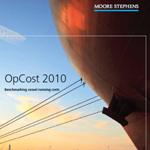OpCost 2010: Ship Operating Costs Down
 International accountant and shipping consultant Moore Stephens reports an average fall of 2.0% in total annual operating costs in OpCost 2010, its unique ship operating costs benchmarking tool. This is the first time since 2002 that OpCost has revealed a fall in total operating costs, which compares with the 15.8% average increase recorded in OpCost 2009. All cost categories were down this time, except for crew costs.
International accountant and shipping consultant Moore Stephens reports an average fall of 2.0% in total annual operating costs in OpCost 2010, its unique ship operating costs benchmarking tool. This is the first time since 2002 that OpCost has revealed a fall in total operating costs, which compares with the 15.8% average increase recorded in OpCost 2009. All cost categories were down this time, except for crew costs.
The latest report marks the tenth year of publication for OpCost, which this time includes data from a record 2,550 ships, more than 16% up on the previous year. It also incorporates a new vessel category – LPG carriers of 10-40,000 cbm. Running cost information is obtained on a confidential basis from clients of Moore Stephens, and from other shipowners and ship managers who submit data for inclusion. OpCost is widely used for benchmarking running costs, the preparation and ongoing monitoring of business plans and in forensic accounting. Copies of the OpCost 2010 report are available free to owners who submit their data for inclusion, or can be purchased by contacting Richard Greiner at Moore Stephens London.
Revealing
OpCost 2010 reveals that the majority of vessel categories experienced a decrease in total operating costs in 2009, the financial year covered by the survey. Costs for the main vessel types in the three sectors covered – bulkers, tankers and container ships – were down. The bulker index decreased by 4 index points (or 2.3%) on a year-on-year basis, while the tanker index witnessed a bigger decrease this year of 5 index points (2.7%). The container ship index (with a 2002 base year) experienced the biggest decrease of 13 index points (7.5%), having recorded the smallest increase amongst the three sectors the year before.
Anticipated
Moore Stephens partner Richard Greiner:”These decreases have long been anticipated and are due mainly to the marked fall in costs for stores, repairs and maintenance. The period covered by the report embraces the very peak of the worldwide economic recession, and the effects of that can be seen in each of the cost categories. Repair and maintenance costs, for example, were down by more than 11% in 2009, having shown an average increase over the previous two years of more than 13%. But 2007 and 2008 were comparative years of plenty for shipping, while 2009 saw reduced pressure on labour and material costs at repair yards due to demand reductions.”
Asset
“The rise in P&I costs (Protection and Indemneity – ed.) was to be expected, given the clubs’ need to recover the costs of a number of expensive casualties and to meet the requirements of the regulator in the run-up to Solvency II. And the fall in the cost of other marine insurance is no surprise, given that particular sector’s continuing competitive appetite for business and the decline in vessel values. “Finally, the rise in crew costs, albeit by only just over one-tenth of the figure for the previous year, shows that, despite technical innovation, people are still shipping’s most valuable, and scarcest, asset.”
Robust
“Ultimately, costs are a reflection of what the market will bear. Confirmation of the overall fall in operating costs, coinciding as it does with evidence to suggest that confidence in the industry generally is holding up comparatively well, indicates that shipping is sufficiently robust to survive even the most severe economic downturn.”






